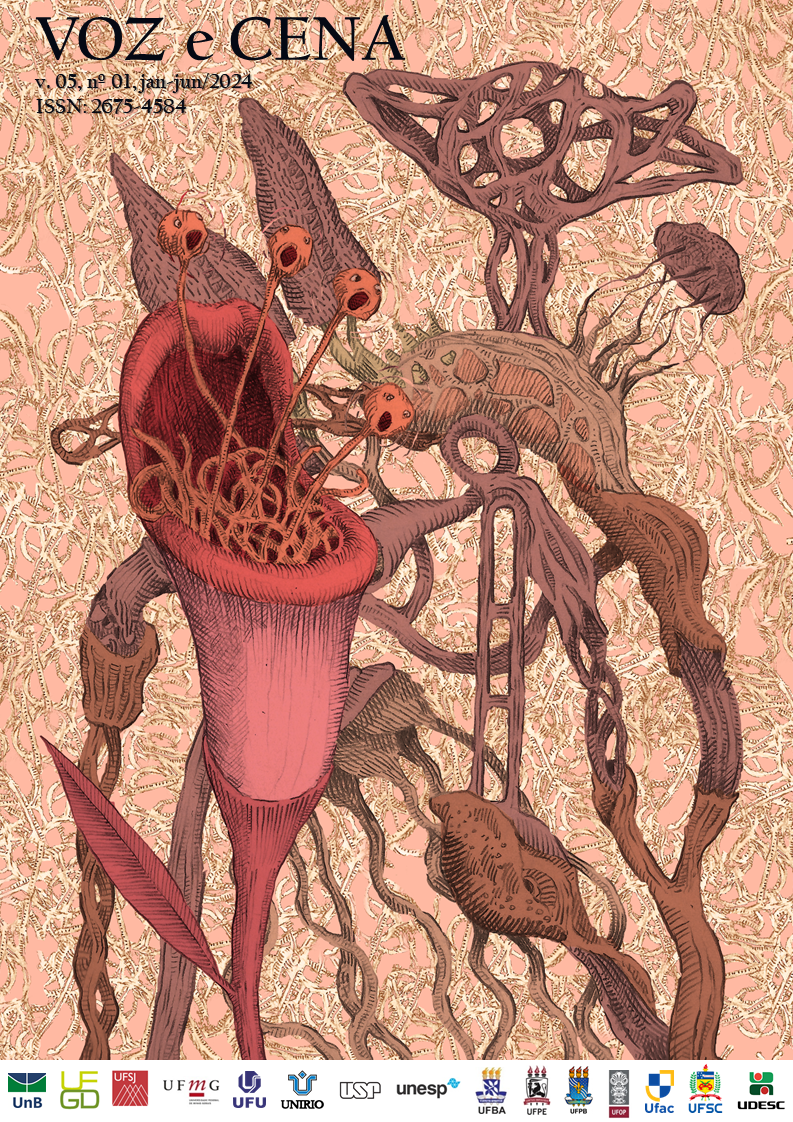I touch-I breathe-I move-I voice-I speak
Somatic logos toward social care
DOI:
https://doi.org/10.26512/vozcen.v5i01.54583Keywords:
Somatic logos, Somatic Listening, Social care, Inter-embodiment, Practice-as-ResearchAbstract
This article advances the author’s concept of somatic logos as an inter-embodied praxical framework that facilitates interrelations between individual and collective voices. It draws from her Practice-as-Research (PaR) project From Haptic Deprivation to Haptic Possibilities and uses the project’s Are We Still in Touch? group workshops as a case study. The workshops investigate how self-directed touch (initiated and managed by oneself) can support one’s sense of care, wellbeing, and creative expression amidst societal shifts catalyzed by the pandemic. Research findings suggest that somatic listening to the self extends to an inter-embodied sense of care with potentials for broader societal impact.
Downloads
References
AHMED, Sara; STACEY, Jackie. Introduction: dermographies. In: AHMED, Sara; STACEY, Jackie (eds.). Thinking through the skin. London: Routledge, 2004. pp. 1-17.
BAINBRIDGE COHEN, Bonnie. Introduction to Body-Mind Centering. In: MILLER, Gill Wright; ETHRIDGE, Pat; MORGAN, Kate Tarlow (eds.). Exploring Body-Mind Centering: an anthology of experience and method. Berkeley, California: North Atlantic Books, 2011. p. 3-11.
BELLARD, Asleigh et al. Vicarious ratings of self vs. other-directed social touch in women with and recovered from Anorexia Nervosa. Scientific Reports, v. 12, article n. 13429, August 2022. Available at: https://doi.org/10.1038/s41598-022-17523-2. Accessed in: June 21, 2024.
BOEHME, Rebecca; OLAUSSON, Hakan. Differentiating self-touch from social touch. Current Opinion in Behavioral Sciences, Elsevier, v. 43, p. 27-33, February 2022. Available at: https://doi.org/10.1016/j.cobeha.2021.06.012. Accessed in: June 21, 2024.
CHARI, Anita. Vocal resonance and the politics of intercorporeality. In: KAPADOCHA, Christina (editor). Somatic voices in performance research and beyond. Abingdon, Oxon: Routledge, 2021. p. 198-211.
DRURY, Lindsey. What’s in a name? Somatics and the historical revisionism of Thomas Hanna. Dance Research Journal, Cambridge, Cambridge University Press, v. 54, n. 1, p. 6-29, April 2022.
EDDY, Martha. Introduction and overview: the what and why of somatic education. In: EDDY, Martha. Mindful movement: the evolution of the somatic arts and conscious action. Wilmington, North Carolina: Intellect, 2016. p. 3-20.
FARNELL, Brenda. Dynamic embodiment for social theory: ‘I move therefore I am’. Abingdon, Oxon: Routledge, 2012.
HANNA, Thomas. Bodies in revolt: a primer in somatic thinking. New York, Holt Rinehart and Winston, 1970.
HANNA, Thomas. The field of somatics. Somatics: Journal-Magazine of the Bodily Arts and Sciences, Novato, California, Novato Institute for Somatic Research and Training, v. 1, n. 1, p. 30-34, Autumn 1976.
JOHNSON, Don Hanlon. Introduction: borderlands. In: JOHNSON, Don Hanlon (ed.). Diverse bodies, diverse practices: towards an inclusive somatics. Berkeley, California: North Atlantic Books, 2018. p. 7-26.
KAPADOCHA, Christina (ed.). Somatic voices in performance research and beyond. Abingdon, Oxon: Routledge, 2021a.
KAPADOCHA, Christina. Somatic logos in physiovocal actor training and beyond. In: KAPADOCHA, Christina (ed.). Somatic voices in performance research and beyond. Abingdon, Oxon: Routledge, 2021b. p. 155-168.
KAPADOCHA, Christina. Tactile renegotiations in actor training: what the pandemic taught us about touch. Theatre, Dance and Performance Training, Abingdon, Oxon, Routledge, v. 14, n. 2, p. 201-215, June 2023.
MACPHERSON, Ben. The somaesthetic in-between: six statements on vocality, listening and embodiment. In: KAPADOCHA, Christina (ed.). Somatic voices in performance research and beyond. Abingdon, Oxon: Routledge, 2021. p. 212-226.
MERLEAU-PONTY, Maurice. The visible and the invisible. Translated by Alphonso Lingis, edited by Claude Lefort. Evanston, Illinois: Northwestern University Press, 1968.
NELSON, Robin. Practice as research in the arts: principles, protocols, pedagogies, resistances. Basingstoke: Palgrave Macmillan, 2013.
PEZZULLO, Pheadra. Resisting Carelessness. Cultural Studies, Abingdon, Oxon, Taylor and Francis, v. 36, n. 3, p. 507-509, December 2020.
STENSTAD, Gail. Merleau-Ponty’s logos: the sens-ing of the flesh, Philosophy Today, v. 37, n. 1, p. 52-61, 1993.
Downloads
Published
How to Cite
Issue
Section
Categories
License
Copyright (c) 2024 Voz e Cena (Voice and Scene)

This work is licensed under a Creative Commons Attribution 4.0 International License.
Readers are free to download, print and use the articles published in the journal, as long as there is always explicit mention to the authors and to the Voz e Cena journal and that there is no change in the original work. Any other use of the texts must be approved by the authors and the journal. By submitting a paper to Voz e Cena journal and having it approved, the authors agree to assign, without remuneration, the rights of first publication and the permission for the journal to redistribute that article and its metadata to the indexing and reference services that its publishers deem appropriate.
This work is licensed under a Creative Commons Attribution 4.0 International License.![]()


7.PNG)


